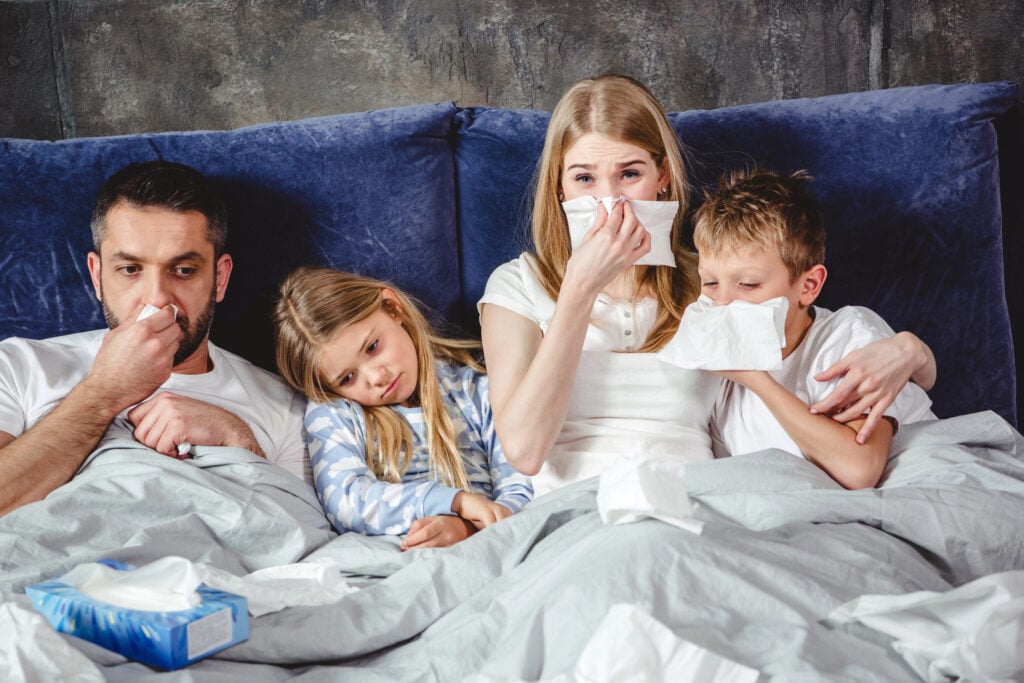
It’s that fun time of year again—the weather is changing, and mornings are cool and crisp. Kids bundle up in jackets to play in the afternoon sunshine, and Halloween decor is out in full force. But with the changing of seasons comes the dreaded influx of germs. It also means parents are left scrambling much of the season, asking, “Does my kid have a common cold or the flu?”
From sniffles and coughs to fevers and stomach bugs – bring on the disinfectant! Flashback to 5 years ago, if your kid had any symptoms, you didn’t dare send them to school. However, as we slowly return to normal, schools are once again pushing for kids to attend, even if they have mild symptoms.
It can be tricky to figure out what virus your child may have, so here we are going to break down some common myths about cold versus flu symptoms, tips for treating viruses at home, and when to call the doctor.
If your child is a baby, we recommend reading our article on flu symptoms in babies.
Facts About The Cold And Flu
The CDC defines the common cold as a viral infection infecting the upper respiratory tract (sinuses, throat, nose, head). There are over 200 viruses that can cause a cold, and you can contract one at any time of year. Cold viruses typically peak around day 2 or 3 after exposure, and most colds last about a week.
The Flu, or influenza, is defined by the Mayo Clinic as caused by specific flu viruses and affecting the upper respiratory tract; in more severe cases, it can also affect the lungs. Most cases of influenza occur during what is referred to as flu season, when the virus is more widely spread. Typical flu season occurs from October to May in the United States. Flu symptoms typically hit hard about 24-48 hours after exposure and can last about 7 days. The respiratory flu virus is not the same virus that causes what is commonly called the “stomach flu.”
Cold Versus Flu Symptoms

A close examination of the two definitions listed above isn’t really enough to determine whether your child has a cold or the flu. I’ve quickly outlined the similarities and differences between the illnesses below.
Common symptoms of the cold and flu include:
- Headache: Kids may complain that their head “hurts” or feel pressure behind their eyes or forehead. Watch for irritability or light sensitivity, which can signal head discomfort.
- Sinus and Nasal Congestion: If your child sounds stuffy, breathes through their mouth, or wakes up congested, it’s likely from sinus inflammation caused by a virus.
- Cough: A mild cough helps clear mucus, but if it’s persistent or keeps your child up at night, track how it sounds — a dry cough is common early, while a wet cough means mucus buildup.
Cold Symptoms:
Along with the symptoms mentioned above, your child may have a common cold if any of the following are observed.
- Sore throat: Your child might say it “hurts to swallow” or “feels scratchy.” It’s usually the first sign of a cold before congestion sets in. Offer warm liquids and gentle reassurance.
Cleveland Clinic – Common Cold in Children - General tiredness: Kids may nap longer, seem less playful, or respond more slowly. Unlike the flu, they can usually still get up and play in short bursts.
- Low-grade fever in young children: Mild fevers (around 99–100°F) are common and short-lived. Keep them hydrated and rest; call your pediatrician if the fever lasts more than a couple of days.
- Mild body aches: Kids might describe feeling “achy” or ask to rest more. Encourage gentle movement and warm baths for relief.
Flu Symptoms:
If your children are experiencing the common symptoms highlighted earlier, be on the lookout for signs of the flu, not just a common cold.
- Fever (above 100 °F): A sudden, high fever is one of the most evident signs of flu. Kids may feel hot and flushed, or shiver and sweat. Check temperatures regularly as a rise in temperature can happen suddenly and at any time.
- Severe muscle aches: When your child says “everything hurts,” especially in the back or legs, that’s a sign of body-wide inflammation from flu, according to Harvard Health.
- Sweating and chills: Watch for shivering or damp skin, even when the room is warm. Alternating chills and sweating are key indicators of flu.
- Extreme fatigue: Flu wipes kids out fast — they may sleep most of the day, lose interest in play, or barely eat. Fatigue can last a week or more.\
IMPORTANT TREATMENT NOTE FOR TAMIFLU: Children and adults can be treated for the flu using Tamiflu; however, it must be taken within 48 hours of the first symptoms to be effective. The faster the drug is taken, the higher the chance it will be effective. A study released way back in 2000 found that treatment within 12 hours reduced total illness duration by more than 3 days compared to taking Tamiflu just short of the 48-hour mark.
Basic At-Home Treatments For The Common Cold And Flu

While both the cold and flu symptoms usually resolve on their own, there are a few things you can do to help the healing process. The CDC recommends the following tips for at-home treatment of both viruses.
Hydration Is Key
Encourage your child to drink plenty of fluids — water is best, but offering an electrolyte drink occasionally is also okay. Staying well-hydrated supports the immune system and helps the body fight infections. According to the American Academy of Pediatrics, plain water and milk are ideal beverages for children.
Prioritize Rest
Rest is essential to the body’s immune response. Allowing your child to sleep and limit physical exertion helps avoid extra strain on their system and supports faster recovery.
Monitor Temperature Carefully
Keep a close eye on your child’s temperature and always follow your pediatrician’s guidelines for their age. Infants are particularly vulnerable and may face higher risks even with lower-grade fevers. The Centers for Disease Control and Prevention defines fever in many settings as a temperature of 100.4 °F (38 °C) or higher.
Don’t Rush to Give Fever-Reducing Medicine
A fever is often the body’s natural way of fighting off viruses. Don’t automatically reach for medication unless your child is in significant pain or distress. If you do choose to give fever-reducing medicine, make sure your child has eaten recently to avoid stomach upset. The AAP notes that mild fevers can be beneficial and don’t always require treatment.
Let Appetite Return Naturally
If your child isn’t feeling well, you don’t have to push meals. As long as they remain well-hydrated, skipping or eating less is typically okay — their appetite should return as they regain strength.
Help With Nasal Congestion
For younger children, using a bulb suction or nasal suction device (like a NoseFrida) can help clear nasal passages. Older children can safely use a saline spray or nasal rinse to ease congestion and breathe more comfortably.
Use a Humidifier for Dry Air
If the indoor air is dry, a clean vaporizer or cool-mist humidifier can help relieve nasal passages and soothe throat irritation — just be sure to keep the unit clean to prevent mold or bacteria from forming.
Throat & Cough Relief (For Older Kids)
Throat lozenges or cough drops may help older children feel more comfortable, but avoid giving these to younger children who may choke on them.
By combining hydration, rest, attentive monitoring, and simple supportive care, you can help your child through a cold or flu episode with greater ease and comfort. If symptoms worsen or you’re unsure about any step, contact their pediatrician or review CDC cold and flu care guidelines for more information.
When To See The Doctor

If you have any concerns about your child at any point during their illness, calling your physician’s office to learn about their protocols and recommendations is fine. But if you are a little more like me and don’t get easily worked up about things, you may find yourself wondering when to take your child to the doctor. Below are some symptoms you should keep an eye out for and justify a trip to your provider.
- Difficulty breathing or shortness of breath
- Wheezing – especially important in children with asthma
- Chest pain or pressure
- Severe dizziness that doesn’t resolve with rest and medications
- Confusion or hard to arouse from sleep
- Dehydration – this is especially concerning for infants; your child should have a wet diaper every few hours
- Fever Seizures – typically harmless and generally don’t have lasting effects, it’s beneficial to have your child evaluated after one
If your child has symptoms that seem to improve and then recur or worsen, call your provider right away.
It can be tough raising a child when they’re sick. Our children can’t always tell us exactly what hurts or how it’s causing them pain. As a parent, you should do your best to listen for breathing problems, look for signs of sweating, and keep in constant communication with your child so you can gather as much information as possible. And, as always, don’t be afraid to contact your health care provider or visit a medical facility when you feel or realize it’s necessary for your child’s well-being.
The information provided is for educational purposes only. It should not be a replacement for medical care or advice. This info is not intended to diagnose or replace medical treatment. Consult your doctor if you have any questions about your child’s potential cold or flu symptoms. If they are experiencing an emergency, contact 911 or transport them to the nearest emergency room.
Most Asked Parent Question
How can parents tell the difference between a common cold and the flu in kids?
While both illnesses share overlapping symptoms, colds tend to develop slowly and stay mild, while the flu hits fast and hard with fever, fatigue, and body aches. The flu is more likely to cause high fevers, severe muscle pain, and exhaustion, while a cold usually causes congestion, sore throat, and low-grade fever. Always monitor your child closely, encourage rest and fluids, and contact your pediatrician if symptoms worsen or breathing becomes difficult.
- Colds are caused by more than 200 viruses that infect the upper respiratory tract (nose, throat, sinuses) and typically peak in symptoms on days 2–3 and last about a week. source Government
- The flu (influenza) is caused by specific influenza viruses, usually circulating during the fall-winter months, and can affect both the upper airways and lungs. source Guideline
- In general, the flu is worse than a cold: symptoms are more intense and begin more abruptly — while a cold develops gradually and stays milder. source Government
- Hydration and rest are among the most important at-home treatments. Encourage plenty of water or plain milk and ample sleep so the body can heal. source association
- Don’t automatically give fever-reducing medicine. A mild fever is often part of the body’s immune response. Unless the child is in significant pain or very uncomfortable, avoid medicating frequently. source association
- Cold and flu seasons differ: Flu viruses typically circulate from fall through spring in the U.S., often from October through May. source Guideline
- Call your child’s doctor if you notice serious symptoms like difficulty breathing, dehydration (especially in infants), chest pain, sudden worsening of symptoms, or a high and persistent fever. source Government

